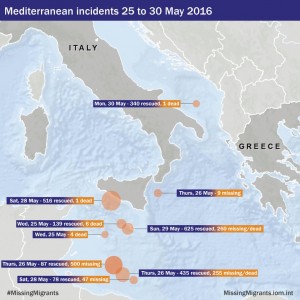By Sami Zaptia.

London, 2 June 2016:
The last seven days of May marked the deadliest week for migrant deaths at sea in . . .[restrict]the Mediterranean in 2016, IOM’s Global Migration Data Analysis Centre in Berlin said in a report today.
It reported that 1,083 migrants are estimated to have died or gone missing in nine separate incidents. The worst tragedy, it reported, occurred on May 26th, about 35 nautical miles north of Zuwara, off the Libyan west coast, in which an estimated 500 migrants disappeared, including 40 children.
Today, bodies of at least 25 dead migrants were reported washed-up near Zuwara. Its not clear if they are migrants who have set off today or they are from previous sailings. With the closure of the Balkan/Turkish route, after the EU struck a deal with Turkey, it is expected that there will be a surge in migrants setting off from Libya.
The IOM report highlights the role of Libya’s western coast in the migration deaths, an area of Libya controlled by the internationally unrecognized Salvation Government of Libya up to 30 March.
The Salvation Government was formed by the rump of the outgoing Libyan parliament, the GNC, which had expired after the 2014 general election to choose the new parliament, the House of Representatives (HoR).
However, a coalition of GNC/Islamist/Misratan militias overthrew the legitimately elected parliament and government by invading Tripoli and forcing the legitimate authorities to flee to the east. A UN-brokered Libyan Political Agreement (LPA) was signed in Skhirat Morocco in December 2015 which chose a new Presidential Council and Government of National Accord (PC/GNA).
With the support of Tripoli-based and Misratan militias, the PC/GNA entered Tripoli on 30 March, bunkering itself in Tripoli’s Abu Sitta Naval base. However, as the volumes of migrants setting off from Libya prove, the authority of the PC/GNA and their militias does not extend far beyond Tripoli’s boundaries, if not its Naval base.
Their authority definitely does not extend over the migrant-smuggling militias across the deadly western Libyan coast stretching all the way from the capital Tripoli to the Tunisian border: the area of the highest concentration for migration departures as the various charity, NGO and UN migration organizations have independently concluded.
Last week’s migrant death toll is second only to that recorded during a week in mid-April 2015, in which 1,229 migrants are estimated to have died in five separate shipwrecks in the Mediterranean, the report added.
The vast majority of these reported fatalities occurred along the Central Mediterranean route between Libya and Italy, while ten migrants perished on their journeys along the Eastern Mediterranean route between Turkey and Greece.
These incidents included two particularly tragic ones: on April 18th 2015 an estimated 800 people died or went missing 120 miles south of the Italian island of Lampedusa, and five days earlier, 400 deaths and disappearances were recorded following a shipwreck 80 miles off the Libyan coast.
These weeks with such high death tolls are a dramatic reminder of how people continue to die in large numbers in their attempt to reach Europe, the report noted. The Central Mediterranean route, between North Africa and Italy, is particularly dangerous. Since 2014, more than 20 incidents along this route have resulted in over 100 recorded deaths and disappearances each.
The report said that this route has seen 27% of sea arrivals to Europe since the beginning of 2014, but accounts for 85% of migrant deaths in the Mediterranean during the same period. It noted that for every fifty migrants who have attempted the Central Mediterranean crossing since 2014, one has died en route. The stark difference in terms of the number of bodies that are recovered from the water, depending on the route, should also be noted, added the report.
In 2016, 80% of the bodies of those who perished in the Eastern Mediterranean have been recovered, whereas less than 10% have been recovered in the Central Mediterranean. This reinforces the fact that the numbers of deaths at sea can never be exact.
In the case of maritime migration, in particular, it is often difficult to determine the total number of people who were on a boat that sank – the only source of information are statements from survivors, who may be traumatized, and are often unsure or unaware of the original number of people on board.
This is also why the estimated number of deaths varies between organizations who are present once survivors are brought to shore. IOM continues to be on the ground at the main landing points in Italy, to interview and provide counselling to survivors, the report added. The Mediterranean currently accounts for almost 90% of recorded migrant deaths around the world so far in 2016, the report revealed. [/restrict]







